





PHOTO GALLERY

Photos by Len Blumin
1. Osprey Cry
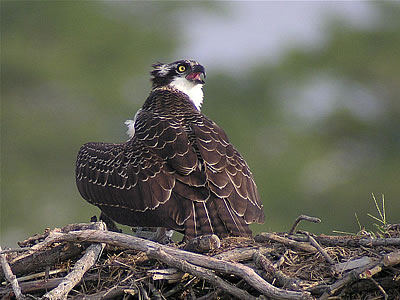
The Osprey (Pandion haliaetus) never fails to entertain. Having recovered well from the DDT days, the Osprey is now widely seen and admired. This handsome specimen, probably a youngster, was nervously enjoying a large fish that she had caught and carried back to the to the safety of the nest site to devour. Every so often a large bird would pass by, perhaps a gull or an egret, and each time the Osprey would alert, screaming her high-pitched whistle and half-spreading her wings to prepare for fight or flight. The feathers of the juvenile birds are tipped with a light buffy color, making for a distinctive display. Females have a more prominent breast band (not shown here), and younger birds have more orange eyes, compared to the yellow of the adults. Taken in East Haven, CT, 26 Aug 07. Distance 150'
Pandion is a monotypic genus, and the Osprey is not closely realated to any other raptor. It was once thought to be a falcon, but now stands alone. Pandion was a mythological king of Athens, and the myth is rather gruesome. "Haliaetus" is Latin for a sea eagle.
2. Ruddy Turnstone - Arenaria interpres
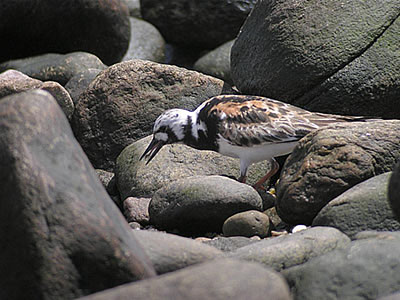
Some day I'd love to see a race between a Ruddy Turnstone and a Sanderling, as both these species can really scoot along the shore. Not an endearing trait for the photographer, for sure. The adult bird shown here is probably starting to molt from the fancy breeding plumage, and if you look closely you can see its tongue and what appears to be a small prey item, perhaps a fly. They eat pretty much anything they find along the shore, often turning over algae and shells to see what's hiding underneath. And yes, they also turn stones, and can open shellfish and barnacles with ease. There are perhaps 250,000 in North America, and they face the usual threats common to shorebirds. Taken late August, 2007, Hammonasset State Beach, CT.
Order: Charadriiformes (Shorebirds, Gulls and Terns, Auks and Murres)
Sub-order: Charadrii (Shorebirds, lots of them!)
Family: Scolopacidae (Sandpipers, Phalaropes, and allies)
Sub-family: Scolopacinae
Tribe: Arenariini -- the turnstones. This tribe is perhaps most closely related to the
Plovers, while in the past they were considered closer to the Surfbird, which they
somewhat resemble. There is only one genus in this family...
Genus: Arenaria -- The turnstones, and there only 2 species, the Black Turnstone (A. melanocephala) and ...
Species: Arenaria interpres -- Ruddy Turnstone. They breed in many arctic regions and
are migrate south to shorelines worldwide, and even to the Galapagos Islands.
3. The Color of Ibis
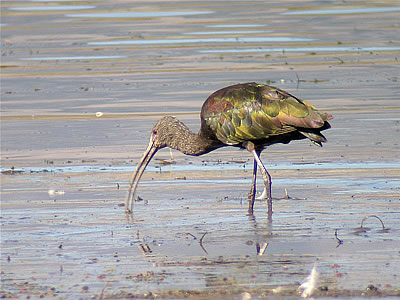
In the west we have the White-faced Ibis, Plegadis chihi, which is quite similar to the Glossy Ibis (P. falcinellus) seen in the Gulf Coast and Eastern Seaboard. On the Gulf Coast they have both, which complicates matters. In non-breeding (basic, or "winter") plumage the species are quite similar, and best separated by iris and face color (Sibley). Another feature that may help tell them apart is the sheen of their plumage. The pigments in their feathers are essentially the same, i.e. blacks/browns/grays, but feather structure can of course change a simple black into an emerald green or purple, as we see in the Mallard. When seen in good light, as here at Crowley Lake (south of Mono Lake) on Sept 14, the drab plumage of the White-faced Ibis shimmers with a palette of greens and purples to delight the eye, perhaps more rosy than the Glossy Ibis. We were impressed with the large size of the covert feathers, as shown here, the color of which changed with every view. The Ibises are large wading birds related to the Spoonbills, and are in the order Ciconiiformes, along with the herons and egrets.
Our trip to the Mono Lake area was led by Rich Stallcup, with the able assistance of Missy Wimpf, as part of an incredible PRBO Conservation Science field trip. They are good people, doing great things for birds and the planet.
4. Bonaparte's Gull
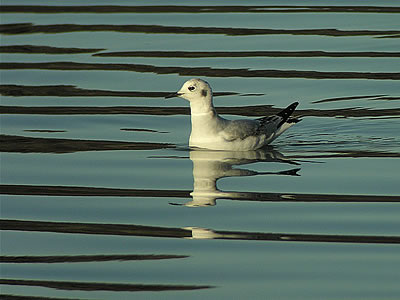
Rich's Stallcup's group gathered early on Oct 7 to scope out Rodeo Lagoon before proceeding to the headlands for raptor viewing. Soon Rich spotted two young Bonaparte's Gulls (Larus philadelphia) and we watched as they fed like terns, picking off prey from the water's surface, and then alit and paddled about like phalaropes. The young Bonaparte's has a pretty black trailing edge on the wing and a black band on the tail. A small and beautiful creature. Note the tern-like bill, somewhat obscured by the wave pattern. We can also see the white eye ring.
5. Blue-winged Teal
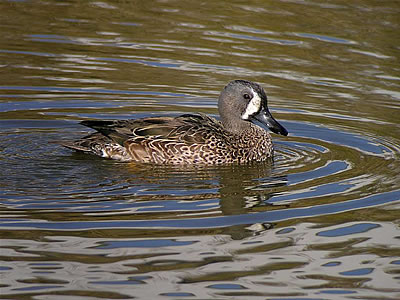
The Gray Hawks visited Shollenberger Park Monday, Oct.15. The group, led by Rigdon Currie, was treated to sightings of 2 specialty birds of this area, the Pacific Golden Plover and the Blue-winged Teal (Anas discors).
Blue-winged Teal breed widely across the southern Canadian provinces and the north/central U.S. (Prairie Pothole Region), then migrate south and reach well down into South America. Migration starts earlier, with the males leaving first, often before the duck-hunters have taken to their blinds. Some winter in U.S. coastal areas, feeding mostly on vegetation. Populations can fluctuate with wetland levels, but overall are stable in the 4-6 million range. Major predator is the non-native Red Fox, which may take up to 900,000 eggs/chicks per year.
Someone asked if they hybridize. Sibley shows the hybrid with the Cinnamon Teal, but they can also hybridize with the Northern Shoveler, and even produce fertile offspring.
The most interesting fact that I'm not sure I wanted to learn (at least I'd rather not meet the scientists who did the study) is that Blue-winged Teal can survive incredible thermal stress. Imagine exposure to -48 C for 24 hours, and later up to 50 C. for a prolonged period. That's a range of 98 C, or over 175 degrees F!! Why someone felt they needed to know this boggles my mind, but it does demonstrate the incredible toughness of our avian friends, as most of the subjects survived this gruesome trial.
Here is a male Blue-winged Teal at Shollenberger October 8th. Body molt probably not completed.
6. Knot the Least
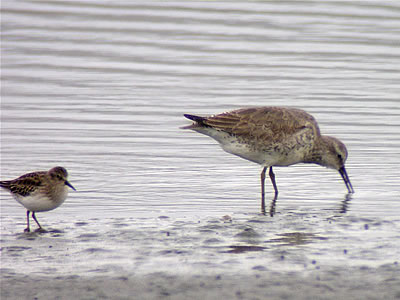
So, just how big is the Red Knot? Well, at 10.5" it is just a tad longer than a Surfbird, and of course much slimmer and grayer. Dowitchers are a bit bigger. Here we see a Red Knot with a Least Sandpiper, which is only about 6" long and weighs less than an ounce. Red Knot weighs in at 4.7 oz. and Surfbird at 7 oz.
7. Surf Scoter at Arrowhead Marsh
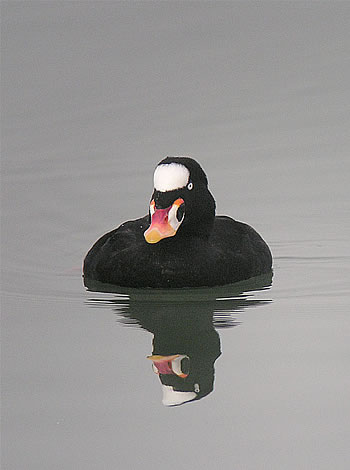
Yesterday [November 7th 2007] Don Reinberg and I hit some spots in the East Bay. Arrowhead Marsh at high tide had lots of Surf Scoters and Greater Scaup, plus the usual clappering rails and five grebe species. Just north of the Oakland Airport, the marsh is a work in progress, and quite worth the visit. The Surf Scoter (Malanitta perspicillata) is a comical looking bird, but hard to photograph. The still water and overcast skies helped a lot. The male "sings" with his wings in flight, producing a haunting tremulous whistle.
8. Marin Motacillid
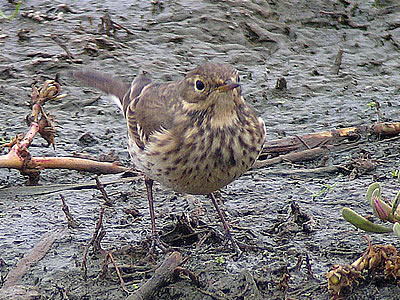
Hmmm. So, what's a "motacillid"?
The family Motacillidae are passerines known as the Wagtails and Pipits. Wagtails are more showy, pipits are drab, but both pump their tails up and down much of the time, like Spotted Sandpipers and others. Friends who travel the world tell me that the pipits all look pretty much alike, which is to say that they are very difficult to identify. There are some 65 species of Motacillids, distributed throughout the world. We have mainly the American Pipit, Anthus rubescens, while Sprague's Pipit is seen in the prairie states. The Red-throated Pipit is seen as a vagrant, as are at least three Wagtails. The Water Pipit is a Eurasian species, closely related to the American Pipit, which was split off by the taxonomists not so long ago.
Pipits forage in a group, looking mostly for insects, but will eat other fauna, and some seeds. Their busyness makes a good photo a challenge, and the movement of the tail helps not at all. So forgive this soft shot, with blurred tail, as it's the best I could do at Las Gallinas recently, where we watched a small group feeding along the shore of pond #1. Note heavily streaked chest, warbler -like bill and pale throat.
TOWHEE.NET: Harry Fuller, 820 NW 19th Street, McMinnville, OR 97128
website@towhee.net